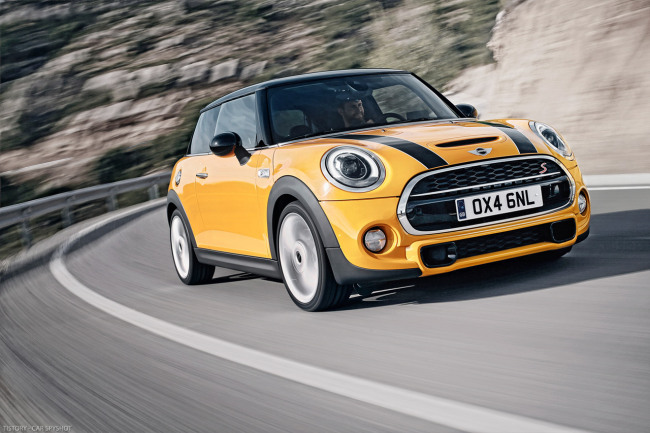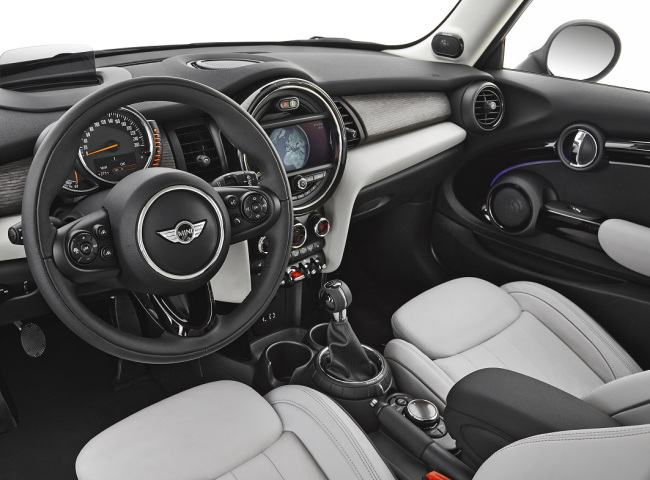Mini has grown up well
More mature now, Mini will please everyone, including enthusiasts
By Korea HeraldPublished : April 13, 2014 - 19:49

For years, the BMW Mini has been on my shopping list. But I was always reluctant to buy one.
My biggest complaints were based on the go-kart feeling that makes the driving experience fun but tiring, even though it is one of the key reasons why Mini enthusiasts admire the car.
But now, after a quick drive of the new, third-generation Mini, I have to admit that I feel no more hesitation.
On Thursday, BMW Korea unveiled a bigger, faster and more high-tech version of its iconic Mini hatchback. Before the official launch, more than 700 preorders had already been made.
While the exterior seems to have undergone a modest makeover, the cabin design has been transformed to offer a much more luxurious ambience.

The optional sports seats, boasting a subtle choice of leather materials and careful design, are aimed at maximizing the fun of driving while reducing the fatigue.
The huge clocklike gauge remains in the center stack, but now serves multiple purposes and includes an optional 8.8-inch display screen for the navigation and other information and entertainment systems.
The LED tube surrounding the gauge changes color depending on the driving mode, for example, green for Eco driving and red for Sport mode.
Some switches that used to be in secret locations such as the door lock and window switches on the center stack are now located in their traditional places ― on the door.
Among other things, I could feel the Mini has grown up well after testing it on the highway and curvy roads near Paju, Gyeonggi Province.
The new Mini comes with a completely new engine and chassis technology. Both the three- and four-cylinder gasoline engines, based on BMW’s downsizing prowess, are significant upgrades.
The Cooper S model I test-drove was equipped with a 2.0-liter four-cylinder turbocharged engine that churns out 192 horsepower and a maximum torque of 28.6 kilogram-meters.
The steering was tight and allowed for aggressive driving, but it was not overly tight. Not only Mini loyalists but also members of the older generation may enjoy the car now.
The new spring-and-damper set-up allowed for the Mini to maintain its body much better. Even considering it was gasoline-powered, the ride was surprisingly quiet compared with previous models.
The based-model Cooper comes with a 1.5-liter three-cylinder engine that boasts 136 horsepower and a maximum torque of 22.4 kilogram-meters. It only takes 7.8 seconds to reach 100 kilometers per hour.
The Cooper and Cooper S models have fuel efficiency of 14.6 and 13.7 kilometers per liter, respectively, not bad for vehicles in their price and size ranges.
The prices are 29.9 million won ($29,000) for the Cooper, 37.2 million won for the Cooper with more high-end features and 42.4 million won for the Cooper S in Korea.
“When we first decided to introduce the Mini back in 2005, people were skeptical about a compact car priced more than 30 million won,” BMW Korea CEO Kim Hyo-joon said of the earlier skepticism in the market.
“Last year, we sold 6,201 Mini vehicles. With the new Mini, the only issue for us is securing more cars to sell.”
By Lee Ji-yoon (jylee@heraldcorp.com)
My biggest complaints were based on the go-kart feeling that makes the driving experience fun but tiring, even though it is one of the key reasons why Mini enthusiasts admire the car.
But now, after a quick drive of the new, third-generation Mini, I have to admit that I feel no more hesitation.
On Thursday, BMW Korea unveiled a bigger, faster and more high-tech version of its iconic Mini hatchback. Before the official launch, more than 700 preorders had already been made.
While the exterior seems to have undergone a modest makeover, the cabin design has been transformed to offer a much more luxurious ambience.

The optional sports seats, boasting a subtle choice of leather materials and careful design, are aimed at maximizing the fun of driving while reducing the fatigue.
The huge clocklike gauge remains in the center stack, but now serves multiple purposes and includes an optional 8.8-inch display screen for the navigation and other information and entertainment systems.
The LED tube surrounding the gauge changes color depending on the driving mode, for example, green for Eco driving and red for Sport mode.
Some switches that used to be in secret locations such as the door lock and window switches on the center stack are now located in their traditional places ― on the door.
Among other things, I could feel the Mini has grown up well after testing it on the highway and curvy roads near Paju, Gyeonggi Province.
The new Mini comes with a completely new engine and chassis technology. Both the three- and four-cylinder gasoline engines, based on BMW’s downsizing prowess, are significant upgrades.
The Cooper S model I test-drove was equipped with a 2.0-liter four-cylinder turbocharged engine that churns out 192 horsepower and a maximum torque of 28.6 kilogram-meters.
The steering was tight and allowed for aggressive driving, but it was not overly tight. Not only Mini loyalists but also members of the older generation may enjoy the car now.
The new spring-and-damper set-up allowed for the Mini to maintain its body much better. Even considering it was gasoline-powered, the ride was surprisingly quiet compared with previous models.
The based-model Cooper comes with a 1.5-liter three-cylinder engine that boasts 136 horsepower and a maximum torque of 22.4 kilogram-meters. It only takes 7.8 seconds to reach 100 kilometers per hour.
The Cooper and Cooper S models have fuel efficiency of 14.6 and 13.7 kilometers per liter, respectively, not bad for vehicles in their price and size ranges.
The prices are 29.9 million won ($29,000) for the Cooper, 37.2 million won for the Cooper with more high-end features and 42.4 million won for the Cooper S in Korea.
“When we first decided to introduce the Mini back in 2005, people were skeptical about a compact car priced more than 30 million won,” BMW Korea CEO Kim Hyo-joon said of the earlier skepticism in the market.
“Last year, we sold 6,201 Mini vehicles. With the new Mini, the only issue for us is securing more cars to sell.”
By Lee Ji-yoon (jylee@heraldcorp.com)
-
Articles by Korea Herald










![[Hello India] Hyundai Motor vows to boost 'clean mobility' in India](http://res.heraldm.com/phpwas/restmb_idxmake.php?idx=644&simg=/content/image/2024/04/25/20240425050672_0.jpg&u=)









